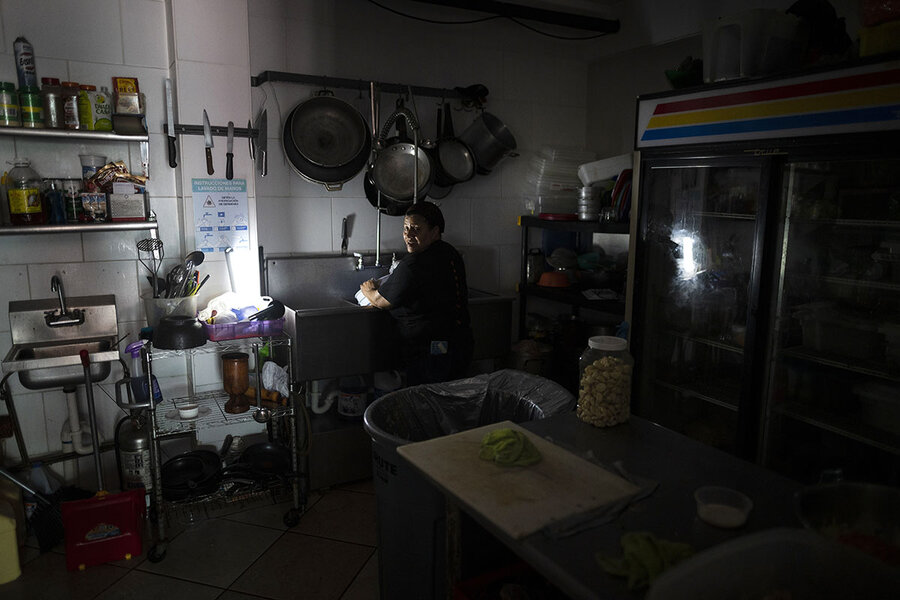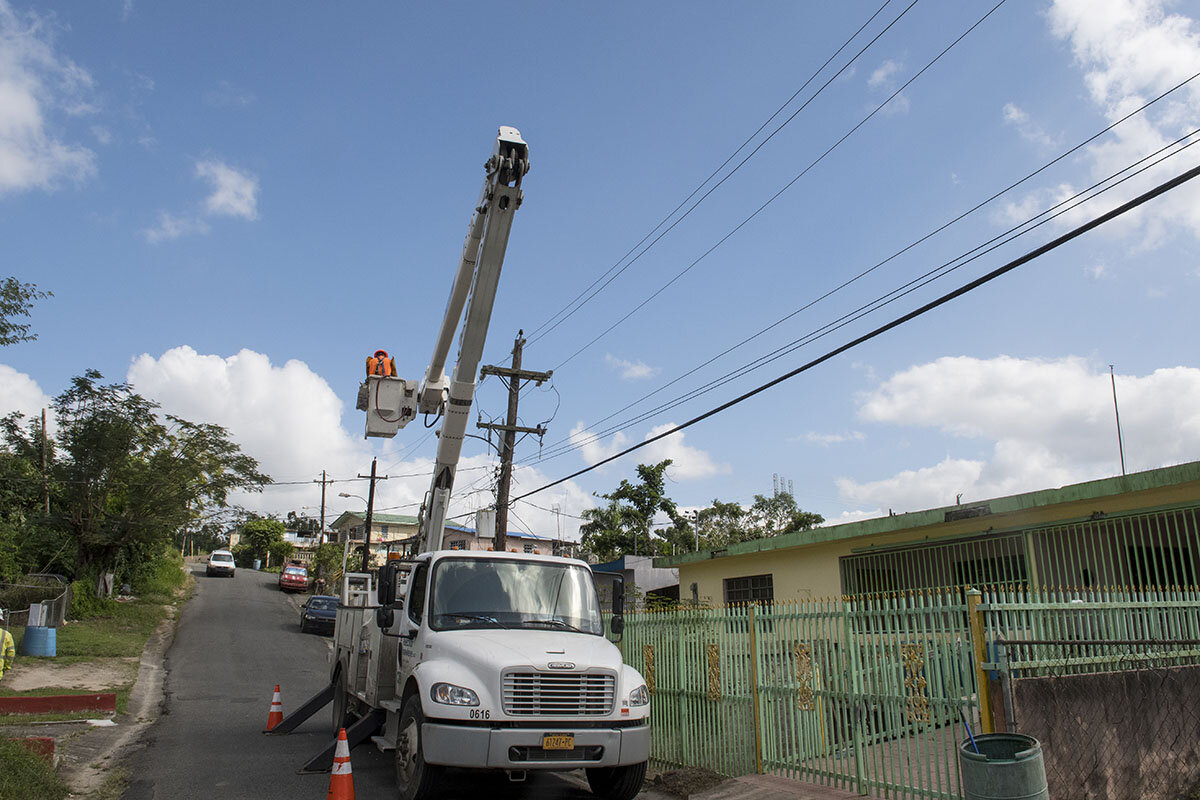Puerto Rico seeks clean-energy revolution. It is getting blackouts.
Loading...
| San Juan, Puerto Rico
Within seconds on a Wednesday evening in early April, more than 1 million Puerto Ricans were without power. Marilu Mayorga and her longtime partner Bill Greenberg were among them.
“The street, it’s total, complete darkness,” Ms. Mayorga said as she stepped outside their home. She could smell the gasoline fumes coming from her neighbor’s generator. She could hear its engine purr. “I’m seeing police lights outside. What’s happening? It’s so dark out here.”
It was dark in many other communities too. One of the island’s four main power plants had suffered the failure of a circuit breaker, erupting in flames. For five days, many Puerto Ricans remained without power. Public schools and government agencies temporarily shuttered.
Why We Wrote This
For Puerto Ricans, Hurricane Maria upended the electricity grid at time when the territory’s government was already mired in bankruptcy. Today, clean-energy ambition is still paired with persistent power outages.
Nearly five years after Hurricane Maria devastated this territory of the United States – claiming nearly 3,000 lives and prompting the longest power outages in U.S. history – Puerto Rico’s electric grid remains far from revived. Instead, its troubles symbolize deep challenges on the island, as climate change calls for both a greener power supply and resilience against increasingly powerful storms.
The devastation of Maria was an unavoidable call to action. The plodding follow-up is raising questions about governance, and is taxing residents’ patience while prompting some to leave the island altogether. Puerto Rico’s population of 3.2 million people is about 11% lower than in 2010.
“There’s a whole generation here, after Maria, that left the island. They couldn’t handle” the dysfunction anymore, says Ramón Luis Nieves, a former member of the Puerto Rico Senate in the San Juan area. “People say, ‘I’m paying more for my electric bill. We have more blackouts than ever. Why bother?’”
The reality here isn’t hopeless, however. Alongside the presence of fuel-burning generators, a fast-growing number of residents are installing their own solar panels. A post-Maria law envisions rapid expansion of clean energy supplies. And the government has recently emerged from a five-year period of bankruptcy, seeking a fresh start, with the U.S. government also pledging $12 billion early this year to bring Puerto Rico’s grid to a state of reliability.
Those are all signs of the kind of ingenuity and collaboration that ultimately could not only repair the grid but also buoy the island’s society and economy, too.
Still, the hurdles are formidable.
Many residents say blackouts are frequent even as their electric bills have in some instances tripled.
“It’s really hard to trust that it will get better if you don’t see, hear, or read about improvements to the infrastructure,” says San Juan resident Olga Otero. “If it doesn’t get better, it doesn’t change.”
When Hurricane Maria struck the territory in September 2017, people in the island’s populated areas were without power for months; for others, such as those living in its mountains, as long as a year.
Puerto Rico’s “Green New Deal”
In 2019, lawmakers approved a law known as Act 17 that would end the Puerto Rico Electric Power Authority’s monopoly on energy distribution. Among the landmark law’s intentions was eliminating PREPA’s use of coal by 2028, and supplying 40% of electricity from renewable sources by 2025, rising to 100% by 2050.
“It’s like Puerto Rico’s ‘Green New Deal,’” says Javier Rúa-Jovet, a solar advocate, global energy attorney, and the former chairman of the Puerto Rico Environmental Quality Board.
But like many well-intentioned clean energy efforts on the U.S. mainland, Act 17’s ambitions have so far fallen short. Local residents and experts see a mix of complicating factors here, from bureaucratic foot-dragging to a long-standing failure to open the island’s electricity market to greater competition – including in clean energy. In March PREPA announced that the initial goal of 40% renewables by 2025 won’t be met.
Debt is another obstacle. Even with the territory’s overall debt restructuring, PREPA remains saddled with a staggering $9 billion in obligations, to be paid back through higher utility rates over the next 47 years. In March, amid rising global energy prices, Puerto Rico Gov. Pedro Pierluisi canceled that debt paydown plan, saying it was not feasible. Arty Straehla, chief executive of PREPA creditor Mammoth Energy, chided the decision to terminate the debt restructuring as “another example of Puerto Rico and PREPA continuing their resistance to pay their bills.”
At the moment, three years into Act 17, Puerto Rico generates just 3% of its power from renewables, with the rest coming from fossil fuels, such as petroleum (49%), natural gas (29%), and coal (19%), according to the U.S. Energy Information Administration.
Clean energy advocates say that stands in stark contrast to the potential Puerto Rico has for renewable power – everything from utility-scale generation to community microgrids to individual rooftop solar. Recent research by the National Renewable Energy Laboratory found that Puerto Rico receives enough sunlight to meet its residential power needs at least four times over.
Small steps forward
For the territory to succeed in its hoped-for energy revolution, it will require considerable organized effort – yet it may also come due to small actions by people like Carla Giovonnani.
“You have to love your island to stay here and try to move it forward,” says the San Juan resident.
Ms. Giovonnani had solar panels installed on her modest home in a working-class neighborhood earlier this year. She’s been off the grid since March.
She realizes solar power is a luxury many Puerto Ricans, like her father, lack access to. At her father’s business, where he sells school uniforms, when the power goes out, he closes shop.
“He can’t have clients inside his store” because it becomes too hot, Ms. Giovonnani says. If he doesn’t crank the generator during a blackout, “he cannot work.”
Así es la vida en Puerto Rico. That’s life in Puerto Rico, some residents say.
Ms. Otero, also in San Juan, says she panics every time her phone dips below 50% percent charged.
“We, as a country, have some sort of PTSD, because I never let my phone run out of battery,” Ms. Otero says. “Because you never know when you’ll be without a power source. You could have emergencies or something, and then you’re” without a means of reliable communication.
“I’m sure I’m not the only one,” Ms. Otero adds.
Despite the slowness of Puerto Rico’s energy recovery, hope remains on the horizon – in solar.
Mr. Rúa-Jovet notes the change in recent years in how Puerto Ricans view solar as an answer to blackouts. Before Maria struck, less than 1% of the energy used on the island was coming from distributed solar. Now that amount, while still modest, has nearly tripled in a few years.
“When events like yesterday and today’s blackouts happen, it just multiplies,” Mr. Rúa-Jovet says.
In the tiny town of Maricao, with 5,000 people, locals recently began moving to build their own microgrid. The mountain community was awarded the opportunity through the Interstate Renewable Energy Council. Out of 12 municipalities that applied for the grid in Puerto Rico, Maricao was deemed the most needed.
While such community-based solutions may become increasingly common, many towns and neighborhoods across the island are, for now, awaiting a fix – at times, in darkness.
Ms. Mayorga and Mr. Greenberg’s power in Dorado remained off for three days after the Costa Sur power plant failure. In such events, they go through a routine, with Mr. Greenberg tossing an extension cord off their home’s balcony and then running it to the generator next door. Their neighbor generously lets them borrow its power to make up for the engine’s smell.
Meanwhile, the outage disrupts their remote work lives. The dysfunction has begun to weigh on them, as it has for many in Puerto Rico. The couple is unsure of what comes next, or if they’ll stay.
“This is not sustainable,” Ms. Mayorga says.







